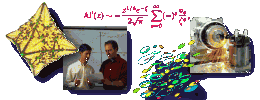Nanostructure modeling is the computation
of the positions and orbitals of atoms in
arbitrary nanostructures.
Accurate atomic-scale quantum theory of
nanostructures and nanosystems fabricated
from nanostructures enables precision
metrology of these nanosystems and
provides the predictive, precision modeling
tools needed for engineering these systems
for applications including advanced
semiconductor lasers and detectors, single
photon sources and detectors, biosensors,
and nanoarchitectures for quantum
coherent technologies such as quantum
computing. The tight-binding model based
upon the Linear Combination of Atomic
Orbitals (LCAO) method provides an
accurate atomistic theory for
nanostructures.
The visualizations are studied interactively in the NIST
immersive environment. This provides a detailed view
of the structures and the atomic scale variation of the
calculated nanostructure properties.
The parallel code outputs the positions of
the atoms and the orbitals.
Then the NanoVis tool
uses multiple processes and shaders to keep the graphics at interactive
frame rates, giving the researcher constant feedback, encouraging data
exploration. Specifically, this tool utilizes the following two programs:
-
Visprep: a preprocessing program, reads atomic positions and associated
orbital data, performs error checking and data analysis, and creates binary
data files which can be quickly read by orbitalVisualization, the
visualization program. This step needs to be performed only once per data
set.
-
OrbitalVisualzation: reads the binary files into memory and starts two
asynchronous background process: one that calculates which orbitals should
be displayed based on the parameters of a selected geometric shape, and one
that modifies the position and geometry of the selected shape.
OrbitalVisualzation also creates several GUIs that control which orbitals
are to be displayed and how they will be presented.
Orbitals are of two types; P orbitals, which are axis aligned dumbbell
shapes, and S orbitals, which are spherical. OrbitalVisualzation uses a set
of graphic shader programs to create S and P orbital shapes and to
dynamically determine which objects should be drawn; this allows a greater
number of orbitals to be displayed than by using traditional graphics
techniques. Using shaders, OrbitalVisualzation can represent an S orbital
by a point, a P orbital by two points, and the orbital selection by a
texture map, which drastically reduces the amount of data to pass to the
graphics card.
 |
Papers/Presentations
 |
G. Bryant, M. Zielinski, N. Malkova, J. Sims, W. Jaskolski and J. Aizpurua, Effect of Mechanical Strain on the Optical Properties of Quantum Dots: Controlling Exciton Shape, Orientation, and Phase with a Mechan
ical Strain,
Physical Review Letters, 105
(6)
,
2010.
ID: 067404.
Note: Pages 067404-1 to 067404-1=4 DOI: 10.1103/PhysRevLett.105.067404 |
 |
G. Bryant, N. Malkova, J. Sims, M. Zielinski, W. Jaskolski and J. Aizpurua,
Re-engineering the optics of quantum dots with mechanical strain
in Optics of Excitons in Confined Systems (OECS11), Madrid, Spain,
September 7-11, 2009.
|
 |
G. Bryant, N. Malkova, J. Sims, M. Zielinski, W. Jaskolski and J. Aizpurua,
Re-engineering the optics of quantum dots with mechanical strain
in Electronic Materials Conference, University Park, PA,
June 24-26, 2009.
|
 |
James S. Sims, W. L. George , Terrence J. Griffin , John G. Hagedorn, Howard K. Hung, John T. Kelso, Marc Olano, Adele P. Peskin, Steven G. Satterfield, Judith E. Terrill, Garnett W. Bryant and Jose G. Diaz, Accelerating Scientific Discovery Through Computation and Visualization III. Tight-Binding Wave Functions for Quantum Dots,
NIST Journal of Research, 113
(3)
,
May-June, 2008,
pp. 131-142.
Links:
pdf and pdf.
|
 |
James S. Sims, William L. George, Steven G. Satterfield, Howard K. Hung, John G. Hagedorn, Peter M. Ketcham, Terence J. Griffin, Stanley A. Hagstrom, Julien C. Franiatte, Garnett W. Bryant, W. Jaskolski, Nicos S. Martys, Charles E. Bouldin, Vernon Simmons, Olivier P. Nicolas, James A. Warren, Barbara A. am Ende, John E. Koontz, B. James Filla, Vital G. Pourprix, Stefanie R. Copley, Robert B. Bohn, Adele P. Peskin, Yolanda M. Parker and Judith E. Devaney, Accelerating Scientific Discovery Through Computation
and Visualization II,
NIST Journal of Research, 107
(3)
,
May-June, 2002,
pp. 223-245.
Links:
postscript and pdf.
|
 |
Julien C. Franiatte, Steven G. Satterfield, Garnett W. Bryant and Judith E. Devaney,
Parallelization and Visualization of Computational Nanotechnology LCAO
Method
delivered at Nanotechnology at the Interface of Information Technology, New Orleans, LA,
February 7-9, 2002.
Links:
pdf and pdf.
|
 |
Garnett W. Bryant, J. Aizpurua, Rui-Hui Xie, Julien C. Franiatte, Judith E. Devaney, W. Jaskolski, M. Zielinski, S. Lee, J. Kim, L. Jonsson and J. W. Wilkins,
Designing the Nanoworld: Atomic Scale Simulations of Nanostructures and Nanodevices
delivered at NIST Nanotechnology Open House, Gaithersburg, MD,
June 20, 2002.
|
 |
Julien C. Franiatte, Judith E. Devaney, Garnett W. Bryant, Steven G. Satterfield and William L. George,
Building Nanostructures Interactively in an Immersive Visualization Environment
delivered at NIST Nanotechnology Open House, Gaithersburg, MD,
June 20, 2002.
|
|
|
|
|
|












